 Many of us that garden will grow much more produce than our family can consume while still fresh. We share with our neighbors, friends, and family, but there is still a mountain of veggies in the pantry that need to find a good home. Throughout our communities you can find many ways to get your fresh produce into the hands – and stomachs – of those who are not blessed with a backyard garden. You may barter your harvest, sell some at your local farmer’s markets, or donate it to the food banks and soup kitchens in your community.
Many of us that garden will grow much more produce than our family can consume while still fresh. We share with our neighbors, friends, and family, but there is still a mountain of veggies in the pantry that need to find a good home. Throughout our communities you can find many ways to get your fresh produce into the hands – and stomachs – of those who are not blessed with a backyard garden. You may barter your harvest, sell some at your local farmer’s markets, or donate it to the food banks and soup kitchens in your community.
Sharing produce through these outlets will not only clear your pantry, but they will give you a feeling of gratitude and thanksgiving to God. These feelings will come because you were able to share of your gardens harvest with others, especially if you are able to give to those who are not fortunate enough to have a garden and/or fresh produce on their table.
Bartering
Bartering is the exchanging something you have an abundance of for something that you have need of. This practice has been used for centuries in communities around the world including many of our local communities. It gives a beneficial outcome for all parties and can be used for both goods and services. It just may be a good fit for getting your excess produce into the hands of someone who is in need of fresh food that may not have enough money to buy it for themselves. To find opportunities in your area, you can search online for bartering with your favorite search engine – such as Google, Yahoo or Bing – for many results. I found an online bartering newsletter and many other online bartering opportunities with just a cursory search.
Farmers Markets
Many communities have farmers markets. They consist of individual vendors – most of whom are local farmers – who set up booths or stands, indoors or outdoors, to sell locally grown fruit, vegetables and meat products. Some of the wares sold may even be prepared foods and beverages, such as canned goods. Farmers markets, like bartering, have been around since before the industrial age and still exist in many countries around the world. Most communities in the United States have begun a new wave of farmers markets all over the country.
Many farmers markets are open only on specific days of the week (for example, my local farmers market is only open from 7 a.m. to 1 p.m. on Tuesdays and Saturdays), so you’ll want to know that ahead of time. Additionally, some markets require a yearly or seasonal membership fee (in my town, this is $50 a season). This is to cover costs such as advertising the market days and/or maintaining their facility. While these may sound like downsides, the large number of people that a farmers market can attract can be a real benefit if you have a lot of produce to sell.
There are networks online where farmers markets can be found in your community, like the ones listed below in the resource section. If you find that a farmers market does not exist in your community, consider joining together with a few local farmers to create one!
Produce Stand
Many growers in rural areas have been known to put up produce stands along the highways near their farms to sell their excess produce to passersby. These small businesses can give your family an extra income to help meet your family’s needs and help you out with the costs of producing your fruits and vegetables. It will also give these passersby/shoppers an opportunity to buy fresh produce direct from their source – your garden or farm.
Starting your fruit/vegetable stand may be as simple as erecting a small shack with a door and a window that can double as a sales counter and setting up a table out front, when you are open, to set up the lugs of produce as a display of what you have to offer.
Before you go into business, check with your chamber of commerce or other local small business organization to learn your area’s small business regulations and check out what guidelines you’ll need to follow in order to start your fruit and vegetable selling business. You may also want to check out online resources for additional advice.
Donating Produce
Donating the produce that you can’t use is great, as it will not only empty your pantry of excess produce, but it will also meet the needs of others in your community. Most of our communities have food banks as a part of their local community and church outreach programs. There are also many networks that help growers connect with local outreach organizations to get food into the hands of the needy. Feeding America, a non-profit organization based in the U.S., is just one such network. It consists of a network of more than 200 food banks and rescue organizations. They essentially serve every county in the United States and Puerto Rico as the nation’s leading hunger-relief charity. They serve approximately 90,000 programs, which include pantries, soup kitchens, emergency shelters, after school programs, and kid’s cafes. You can fine more information about them at the site listed below.
Other ways to donate your produce is to find places in your community that distribute food to the needy. In my area we have many such organizations that distribute food to needy people in our area. One such organization is called FISH – Friends In Service Helping. They run a thrift store, food bank, emergency shelters, and other charitable outreaches. We also have a battered women’s shelter and many churches that give out food to the needy in their congregations and community. I’m sure that there are many such resources in your area too. A look through your local phone book or an online search may give you the all connections that you need to get your excess produce into the hands of those in need.
Find your produce relief niche and begin getting the surplus of your bountiful harvest into the hands of those who will enjoy it. Happy gardening!
For more information:
- https://www.growingagreenerworld.com/
- https://www.barternewsweekly.com/2010/04/23/bartering-2-0-no-cash-no-problem-2-2112/
- https://www.localharvest.org/farmers-markets/
- https://www.ams.usda.gov/AMSv1.0/farmersmarkets
- https://www.ehow.com/list_6647612_ideas-fruit-stand.html
- https://www.microecofarming.com/html/21-roadside-stands.htm
- https://www.openforum.com/articles/9-business-lessons-from-the-roadside-stand
- https://www.motherearthnews.com/real-food/roadside-fruit-stand-zmaz98fmzkin.aspx
- https://feedingamerica.org/
 Off The Grid News Better Ideas For Off The Grid Living
Off The Grid News Better Ideas For Off The Grid Living




